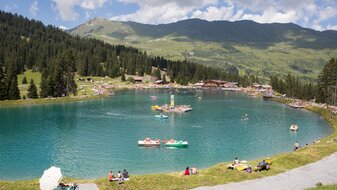17.06.2023 - Basic texts, Summer
Historical flair, time-honoured traditions and lush green Alpine meadows
Lush green Alpine meadows, monolithic mountains and rustic huts – the panorama from the sunny high plateau around the three mountain villages of Serfaus, Fiss and Ladis is simply breath-taking. Not to forget the clear mountain air and reams of sunshine. The Romans also placed great store by this in their day and set up a rest stop in Ladis on Via Claudia Augusta, the first real road across the Alps. Today, it is outdoor summer holidaymakers above all who enjoy the benefits of the Serfaus-Fiss-Ladis holiday region. Whether it is the magnificent view of the Samnaun mountain range and the Ötztal Alps, the programme of activities or the regional cuisine, the Serfaus-Fiss-Ladis holiday region wants to make the holidays as varied as possible for families, enthusiasts and outdoors people. And the best thing is that, despite the almost unlimited possibilities that the Serfaus-Fiss-Ladis holiday region offers, each of the three villages has retained its authentic character.
Serfaus: car-free summer holidays without the stress and hectic pace
Since the entire centre of the mountain village of Serfaus is low in traffic, the village impresses with its unbeatable infrastructure. Not only can its 1,141 residents breathe a sigh of relief because of this, but holidaymakers as well, because a walk through the village centre or a shopping spree make for a relaxing pleasure. The same goes for a ride on the world's smallest and highest village underground, which floats on air cushions. It takes holidaymakers from the eastern end of Serfaus to the western end in no time at all, stopping at four stops on the way, starting at the car park in the east to the church, to the centre and finally to the cable car in the west. And it takes you back again as well of course.
By the way, those with an interest in culture should take a look at the Campanile, the 36-metre high church tower. Tradition says that it stands on the site of a former Roman watchtower. The 800-kilogramme Löffler bell from 1577 is quite remarkable. Of interest as well is the pilgrimage church "Unsere Lieben Frau im Walde", one of the oldest churches in Tyrol. And anyone interested in the perpetuality and change in religious customs over the centuries should make a visit to the local parish museum.
Fiss: original charm and time-honoured traditions
The tranquil village of Fiss has around 1,000 inhabitants and still exudes the original charm of a Romansh clustered village. It wasn't until 1928 that Fiss received its own access road. Before that it only had a hand-cut cart track for ox teams. The largest attraction is the 600-year old village centre with its narrow, winding streets and massive farmhouses with their immense, semi-circular entrances. No wonder old customs are still preserved there. For example, the Sacred Heart of Jesus fires, which light up the Tyrolean mountains on the third Sunday after Pentecost. This tradition dates back to as early as 1796 and is still celebrated with pride today. If you want to learn more about local traditions, why not visit the local "s'Paules and s'Seppls Haus" museum. It is situated in a stately courtyard, which attracts enough attention on its own, because of its large arched door, tiny windows and ornate roof structure.
Ladis: picturesque farmhouses and therapeutic mineral water
With 536 inhabitants, Ladis is the smallest of the three villages, but is still bursting with history. Open staircases, carved gable struts and historic backing ovens still characterise the Romansh face of the village today. This is something that the residents are proud of and they have lovingly restored the centuries-old farmhouses with their impressive frescoes. Worth mentioning in relation is the impressively painted Rechelerhaus, which is one of the most typical and oldest secular buildings in Oberes Gericht today. The Sauerbrunn spring, one of the oldest healing springs in Tyrol, is also of importance. It was discovered by a shepherd in 1212. In the 16th century, people at the Court of Maximilian in Innsbruck were convinced of its beneficial properties and had the healing water delivered to them from Ladis. Until the mid-20th century, noble people and wealthy citizens from Switzerland and Bavaria travelled to this small village to take bathing and drinking cures. Today, guests and locals still drink this delicious mineral water to quench their thirst. Laudeck castle towers over the village on a mighty rock on its north-eastern edge. Until the 16th century, it served as the administrative seat of Oberes Gericht.
About Serfaus-Fiss-Ladis
True to the motto “The fantastic mountain worlds of Serfaus-Fiss-Ladis”, the Tyrolean holiday region represents variety and completely carefree summer holidays at the highest level. For singles as well as best friends, families or three-generation groups. Because in Serfaus-Fiss-Ladis the mountains not only have plenty to offer the grown-ups, but also the little ones. The three mountain villages, each of which enjoy history in abundance, are situated on a sunny high plateau above the Tyrolean Upper Inntal valley, surrounded by the striking mountain peaks of the Samnaun mountain range and the Ötztal Alps. Between 1,200 and 3,000 meters above sea level, the holiday region offers all guests the best conditions for a unique summer vacation: Variety for the whole family. Activities for outdoor sports enthusiasts. Adventures for thrill seekers. Breath-taking panoramas for those who like to take it slow. Extraordinary specialties for food lovers. And that is not only fabulous, but simply fantastic.















